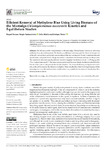Efficient Removal of Methylene Blue Using Living Biomass of the Microalga Chlamydomonas moewusii: Kinetics and Equilibrium Studies

Use este enlace para citar
http://hdl.handle.net/2183/30345Colecciones
- Investigación (FCIE) [1221]
Metadatos
Mostrar el registro completo del ítemTítulo
Efficient Removal of Methylene Blue Using Living Biomass of the Microalga Chlamydomonas moewusii: Kinetics and Equilibrium StudiesFecha
2022-02-24Cita bibliográfica
Seoane, R.; Santaeufemia, S.; Abalde, J.; Torres, E. Efficient Removal of Methylene Blue Using Living Biomass of the Microalga Chlamydomonas moewusii: Kinetics and Equilibrium Studies. Int. J. Environ. Res. Public Health 2022, 19, 2653. https://doi.org/10.3390/ijerph19052653
Resumen
[Abstract] The efficiency of the living biomass of the microalga Chlamydomonas moewusii in removing methylene blue dye is determined. The kinetics, equilibrium isotherms, and the effects on this process of the pH, contact time, and initial concentration of the dye are studied. Fourier transform infrared spectrometry and point of zero charge are used to characterize the biomass and explore the process. The maximum removal capacity derived from the Langmuir isotherm is 212.41 ± 4.55 mg/g after 7 h of contact time at pH 7. The removal process is rapid because kinetic studies revealed that the best fit of the data is with pseudo-third-order kinetics. The removal efficiency is dependent on the pH; as the pH increased, the efficiency is higher. These results show that the living biomass of this microalga is a very efficient biosorbent and therefore very suitable for the removal of methylene blue from aqueous solutions.
Palabras clave
Microalga
Dye
Biosorption
Bioremediation
Decolorization
Environmental pollutants
Dye
Biosorption
Bioremediation
Decolorization
Environmental pollutants
Versión del editor
Derechos
Atribución 4.0 Internacional
ISSN
1660-4601






